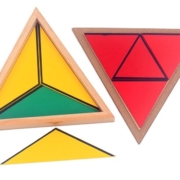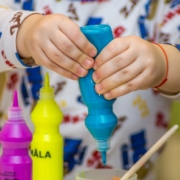Sensorial: Colour Box 1 & 2
Colours are such an important part of life, enabling expression and evoking emotion, but it seems to take children ages to figure them out – their names, in particular. There’s a really great article in Scientific American that explores why it is so difficult for children to learn colour names, and one of the primary reasons is the ubiquity of colour; whenever a three-year-old hears “red”, it is a virtual guarantee that there will be a myriad of other colours and associated hues lurking around just to make things confusing. Distinguishing colours is not as simple as the difference between a cat and a giraffe, for example – other nouns that fall under one genus (animal) but are quite clearly different.

Montessori methodology teaches colour in stages. By encouraging children to focus on a few colours at a time, the ubiquitous, confusing nature of all the red and orange variations accosting their vision is limited. A typical Montessori lesson on colours includes three colour boxes:
Colour Box 1 is a basic lesson, introducing the concepts of colour with primary colours; red, yellow and blue. The lesson requires six rectangular tablets (usually stored in a wooden box) paired in primary colours. The first part of the lesson is a ‘matching game’ whereby the directress will place three colour tablets randomly on the surface, asking the child to match the remaining three colours correctly. Language is introduced by repeating the exercise but naming the colour of each tablet as it is placed on the surface, and then asking the child to find the blue, red or yellow tablet, one at a time. Have a look at the below tutorial by My Works Montessori for a clear application of the colour box exercise:
Colour Box 2, as indicated in the video, introduces the secondary colours to your child as soon as he/she is proficient in the primary colours and shows interest in names and colour combinations. Colour Box 2 includes primary colour rectangles plus secondary colours; brown, pink, orange, purple, green, white, black. The lesson formation mimics Colour Box 1 – first matching and then naming.
Colour lessons are designed to be dynamic and fun, and if, at any point, the child participating in the activity displays frustration or annoyance at the complexity of the abstract naming process, directresses will either repeat the exercise or apply a fun extension, like asking the child to find something blue (for example) in the room. Once confident with the primary and secondary colours in Boxes 1 and 2, children will move on to Colour Box 3 – a lesson for another blog!
If you’d like further information about this tutorial, feel free to contact us at info@saintandrewsmontessori.com. We’re happy to answer any questions.















